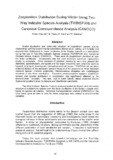Zooplankton distribution during winter using Two-Way Indicator Species Analysis (TWINSPAN) and Canonical Correspondence Analysis (CANOCO).
Share
abstrak
Spatial distribution and community structure of zooplankton species and its relationships with the environmental parameters (temperature, salinity, and turbidity and phytoplankton distribution) in some sandbanks of the Belgian coastal zone was carried out by the use of Two-Way Indicator Species Analysis (TWINSPAN) and Canonical Correspondence Analysis (CANOCO). There were 49 zooplankters identified all over the three sandbanks. Crustaceans was the most dominant sub-phyla represented mostly by copepods. Other members of plankton community were also present like cladocera, appendicularia, pteropoda and the larger omnivores and carnivores such as hyperiid, amphipod, chaetognath, ctenophore and fish larvae. TWINSPAN did not show a distinct division of the sandbank stations because of the presence of three dominant copepod species (Temora longicornis, Pseudocalanus elongatus and Centropages hamatus) in the three sandbanks. Canonical correspondence analysis (CANOCO) showed that species distribution of zooplankton was significantly affected by the environmental variables. This was due to lower salinity values observed around Buitenratel sandbank than Gootebank and Westhinder sandbanks.
Two-Way Indicator Species Analysis analyzed spatial distribution and community structure of zooplankton species over the three sandbanks of the Belgian coastal zone based on species abundance. Canonical Correspondence Analysis (CANOCO) on the other hand, gave an idea on how far these subgroups were related to environmental variables.
Suggested Citation
Caturao, R., Tackx, M., Daro, N., & Sanares, R. (1998). Zooplankton distribution during winter using Two-Way Indicator Species Analysis (TWINSPAN) and Canonical Correspondence Analysis (CANOCO). In 7th National Convention on Statistics, December 2-4, 1998, Shangri-la’s EDSA Plaza Hotel, Manila, Philippines (Vol. 2, pp. 87-103). Manila, Philippines: Philippine Statistics System; National Statistical Coordination Board.

